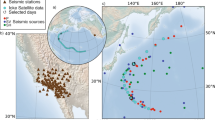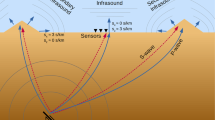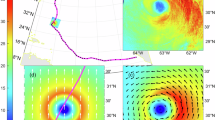Abstract
BOTH infrasonic air pressure waves with periods of 4–6 sec, known as microbaroms1, and seismic ground waves or microseisms, are generated within marine cyclonic storms. This communication considers briefly the origin of microbaroms and their relationship to microseisms and describes and interprets the recently observed semi-diurnal variation of microbaroms. The general characteristics of microbaroms have been described elsewhere—for example, as summarized by Donn and Posmentier2.
This is a preview of subscription content, access via your institution
Access options
Subscribe to this journal
Receive 51 print issues and online access
$199.00 per year
only $3.90 per issue
Buy this article
- Purchase on SpringerLink
- Instant access to full article PDF
Prices may be subject to local taxes which are calculated during checkout
Similar content being viewed by others
References
Benioff, H., and Gutenberg, B., Bull. Amer. Meteorol. Soc., 20, 421 (1939).
Donn, W., and Posmentier, E., J. Geophys. Res., 72, 2053 (1967).
Cook, R., Fourth Intern. Cong. Acoustics, Copenhagen (1962).
Posmentier, E., Geophys. J. (in the press).
Longuet-Higgins, M. S., Phil. Trans. Roy. Soc., 243, 1 (1950).
Saxer, L., Arch. Meteorol. Geophys. Bioklimatol., A, 6, 451 (1954).
Stolov, H., J. Meteorol., 12, 117 (1955).
Author information
Authors and Affiliations
Rights and permissions
About this article
Cite this article
DOWN, W. Natural Infrasound of Five Seconds Period. Nature 215, 1469–1470 (1967). https://doi.org/10.1038/2151469a0
Received:
Revised:
Issue date:
DOI: https://doi.org/10.1038/2151469a0
This article is cited by
-
Properties of pressure fluctuations in an atmospheric boundary layer
Boundary-Layer Meteorology (1975)
-
Microbaroms on a Northern Quarter of the Earth's Surface
Nature Physical Science (1972)



